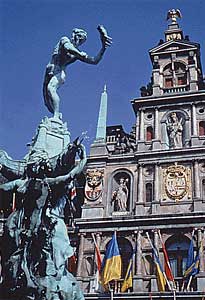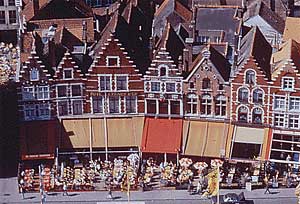
|
Introduction to Belgium | Brussels | History | Art Cities Art Cities In the north is a land of tree-lined canals, gorgeous skies, rich fields, beguinages, carillons, festivals and breweries. If time is limited, rush to see the most important sites, the great sister cities of Antwerp, Bruges, and Ghent. If you have more time, there are many small, charming towns to discover. Antwerp
More of his paintings are in the museum together with the works of his pupil Anthony van Dyck , as well as Teniers, Breughel, Jordaens, Matsys, Permeke, Ensor and many more. The Plantin Moretus Museum will give you an idea of how a 16th century printing plant actually worked. Today it houses priceless bibles, books, prints, as well as the family portraits by Peter Paul Rubens. Among the city's many other attractions are the Diamond Museum where the entire process of diamond mining and processing can be viewed.. Antwerp is the very center of the world's diamond industry. More than 70% of the world's diamonds are cut, polished and traded here. Also worth a visit is the Antwerp Zoo. On the grounds of the nearby estate of Middleheim is the open-air Museum of Modern Sculpture, which exhibits works by virtually all major sculptors from Rodin to the present day. Antwerp has a very lively night life. A famous opera house, concerts, ballets and theatres provide entertainment for the culturally hungry. If you really want to see the local scene, join a group of animated beer-pub crawlers and sample a few of our 400 beers. Bruges
The wash of the flood waters made the Zwin into an ideal trade river, and Bruges soon prospered. Between the 13th and 15th centuries, the city became one of the richest in the world, its trade supplemented by fine cloth manufactories and excellent banking services. Its population soared, its port welcomed ships from all over the known world, its artisans produced tapestries, sculpture, paintings and lace of unparalleled splendor, and its wealthy citizens patronized the finest artists of the age. By the middle of the 16th century, all this had changed. The Zwin had begun to silt up, discouraging the passage of commercial shipping. Trade routes shifted and the cloth industry declined. After suffering a series of sieges and attacks over the next few centuries, Bruges had by the 18th century become a ghost of its former self. At its city center, Bruges remains a medieval city of stunning beauty and charm. It is rich in architectural and artistic treasures, graced by quiet canals and waterways and a favorite to visitors. The Belfry (13th and 15th century) at the old city center is widely considered Belgium's finest, with a carillon that has rung out the quarter hour for nearly seven and a half centuries. Undoubtedly the most enjoyable way to visit Bruges is to amble along its cobbled streets, glide by boat along its tranquil canals and discover a city that time has forgotten. Among the city's most notable monuments are the Memling Museum, housed in the church of the medieval Hospital of St. John, the Groeningen Museum, and the Church of Our Lady. The Memling Museum, as its name suggests, contains as its primary attraction six works by the Flemish painter Hans Memling (c. 1430-1494). The most renowned of these is the Shrine of St. Ursula, a reliquary decorated by several extraordinary paintings illustrating the legend of the saint. Memling set the legend in the Europe of his own time and one of the most fascinating aspects of the panels is their painstakingly accurate portrayal of his contemporary world. GhentAround the year 867, Baldwin Iron Arm, the first Count of Flanders, decided to build a castle at the meeting of the Lieve and Leie rivers in order to thwart the depredations of the raiding Norsemen. A town soon grew up around the castle, and Baldwin adopted it as the seat of his domain. By the 12th century, the castle had been enlarged and strengthened and the town of Ghent was rapidly growing into a prosperous city. The cloth trade flourished here like nowhere else and within a century Ghent had become an industrial city with a population greater than that of any city in Europe. Such prosperity brought the workers and citizens into conflict with the ruling nobility; and the city experienced frequent clashes between the two for the next several centuries. By the late 15th century, the cloth trade had begun to wane, though Ghent remained prosperous by shifting its economy to the shipping trade along the Leie and Scheldt rivers. In the latter part of the century, however, the closing of the Scheldt brought commercial decline, not to be reversed until the revival of clothworking during the industrial boom of the 19th century. Today Ghent is a leading industrial center and a major inland port. However, its historic center, including the medieval districts, many fine churches, and the imposing castle of the Counts of Flanders, remain intact. Its Belfry (or Belfort) and Cloth Hall are among the finest monuments of the great era of Flemish clothworking, and within the magnificent Cathedral of Saint Bavo resides one of the greatest works of art ever created--The Adoration of the Mystic Lamb--also known simply as the Ghent Altarpiece, by the brothers Van Eyck. This masterful polyptych should not be missed by any visitor to Belgium. Other Towns In Flanders
The Ardennes | Art Cities Overview Introduction to Belgium | Brussels | History | Art Cities This page, and all contents of
this Web site are Copyright (c) 1996-2005 |

